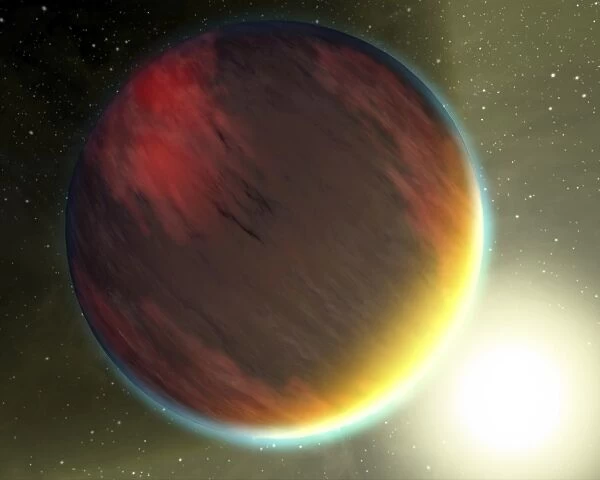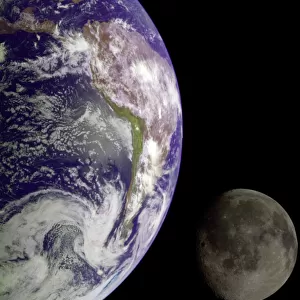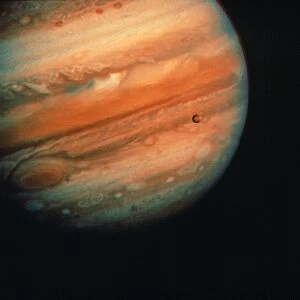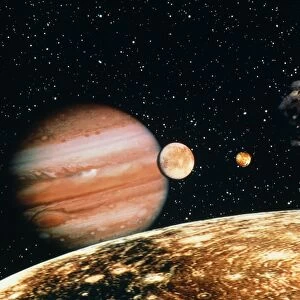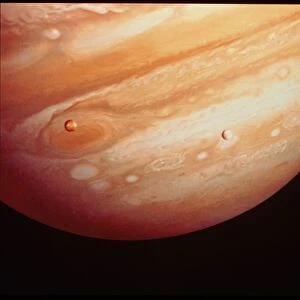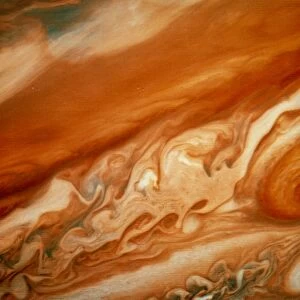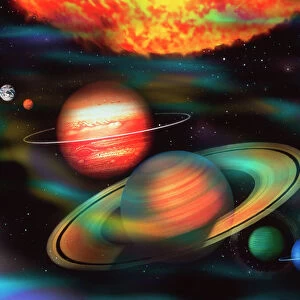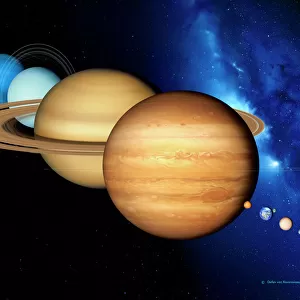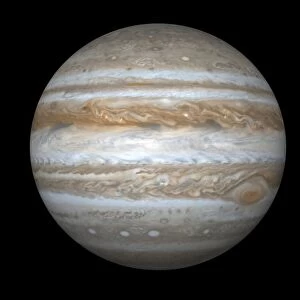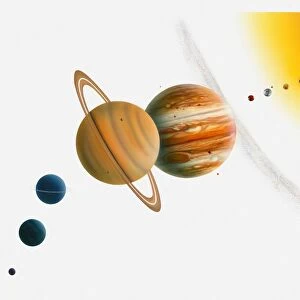Home > Stocktrek Images > Space
A cloudy Jupiter-like planet that orbits very close to its fiery hot star
![]()

Wall Art and Photo Gifts from Stocktrek
A cloudy Jupiter-like planet that orbits very close to its fiery hot star
This artists concept shows a cloudy Jupiter-like planet that orbits very close to its fiery hot star. The Spitzer Space Telescope was recently used to capture spectra, or molecular fingerprints, of two hot Jupiter worlds like the one depicted here. This is the first time a spectrum has ever been obtained for an exoplanet, or a planet beyond our solar system. The ground-breaking observations were made with Spitzers spectrograph, which pries apart infrared light into its basic wavelengths, revealing the fingerprints of molecules imprinted inside. Spitzer studied two planets, HD 209458b and HD 189733b, both of which were found, surprisingly, to have no water in the tops of their atmospheres. The results suggest that the hot planets are socked in with dry, high clouds, which are obscuring water that lies underneath. In addition, HD209458b showed hints of silicates, suggesting that the high clouds on that planet contain very fine sand-like particles. Capturing the spectra from the two hot-Jupiter planets was no easy feat. The planets cannot be distinguished from their stars and instead appear to telescopes as single blurs of light. One way to get around this is through what is known as the secondary eclipse technique. In this method, changes in the total light from a so-called transiting planet system are measured as a planet is eclipsed by its star, vanishing from our Earthly point of view. The dip in observed light can then be attributed to the planet alone. This technique, first used by Spitzer in 2005 to directly detect the light from an exoplanet, currently only works at infrared wavelengths, where the differences in brightness between the planet and star are less, and the planets light is easier to pick out
Stocktrek Images specializes in Astronomy, Dinosaurs, Medical, Military Forces, Ocean Life, & Sci-Fi
Media ID 13058303
© Stocktrek Images
Astrobiology Bright Cloudy Epistellar Jovians Exobiology Exoplanet Extrasolar Gas Giants Giant Planets Glow Halo Hot Jupiters Illuminated Jupiter Light Luminous Orange Orbit Pegasean Planets Pegasids Planet Planetary Science Roaster Planets Round Shining Spectrum Sphere Spectra View From Space
FEATURES IN THESE COLLECTIONS
> Arts
> Artists
> Related Images
EDITORS COMMENTS
This print showcases a cloudy Jupiter-like planet, situated perilously close to its scorching hot star. Crafted by an artist's imagination, this depiction represents a groundbreaking discovery in the field of exoplanet exploration. Utilizing the Spitzer Space Telescope, scientists have successfully captured spectra or molecular fingerprints of two "hot Jupiter" worlds similar to the one portrayed here. These observations mark an unprecedented milestone as they represent the first time that spectra have been obtained for planets beyond our solar system. The Spitzer spectrograph played a pivotal role in unraveling these mysteries by dissecting infrared light into its fundamental wavelengths and revealing the hidden signatures of molecules within. Surprisingly, both studied planets - HD 209458b and HD 189733b - exhibited no traces of water at their atmospheric summits. Instead, dry high clouds shroud these scorching celestial bodies, concealing water beneath them. Additionally, HD209458b displayed indications of silicates, suggesting that fine sand-like particles reside within its lofty cloud cover. Capturing these spectra was no easy feat since distinguishing planets from their stars is challenging; they often appear as mere blurs of light through telescopes. However, employing the secondary eclipse technique allowed researchers to measure changes in total light during a planet's eclipse by its star. This method enabled them to attribute observed dips in brightness solely to the planet itself. As we delve deeper into understanding distant planetary systems through such remarkable discoveries and innovative techniques like those employed by Spitzer Space Telescope, we continue to unlock new realms and broaden our knowledge about worlds far beyond our own.
MADE IN THE USA
Safe Shipping with 30 Day Money Back Guarantee
FREE PERSONALISATION*
We are proud to offer a range of customisation features including Personalised Captions, Color Filters and Picture Zoom Tools
SECURE PAYMENTS
We happily accept a wide range of payment options so you can pay for the things you need in the way that is most convenient for you
* Options may vary by product and licensing agreement. Zoomed Pictures can be adjusted in the Cart.

